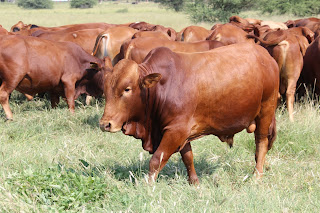Today started bright and early at
5:30 am with a light breakfast before loading up to dart wildlife! Surprisingly,
we fit our group into three vehicles. One of the trucks had stadium seating so
everyone had a unique experience and wonderful view! More than just a fun
experience, there was a specific purpose to darting and moving these animals. To
prevent overgrazing, inbreeding, and fighting among younger and mature males,
animals need to be relocated to a new location within the property. Once
located, the veterinarian darted the animals with a sedative, and the SDSU
students carried the animals and loaded them into the back of the trucks. We
then rode with the Sable and Nyala to their new location. Before turning them
loose the vet dewormed, vaccinated, and collected data on each animal.
We returned to the main camp where a
full breakfast was waiting for us! We loaded up again and went to learn about
the Afrikaner cattle raised at Trekpad. Our first stop was to look at the bulls
and learn how producers are increasing the number of Afrikaner cattle in South
Africa through marketing and breeding programs. Next, we drove to the top of a
nearby mountain where Trekpad keeps their female cattle. This environment was
much different from the base camp area because it had steep terrain and lower
quality forage (which is referred to as sour grass). Because of this, they
strive to produce cattle that are able to produce high quality calves while
grazing low quality forage. There were many interesting aspects to Trekpad’s
cattle operation, like the use of a dipping vat to prevent ticks and branding
birth year of the females on the rear hip. The veterinarian even demonstrated
how to do a pregnancy examination on the cows and let students try it
themselves!
After
enjoying lunch on the covered porch while the rain poured down, we drove
further up the mountain to experience amazing views! This spot is referred to
as Tiger Cliff. We returned down the mountain to learn about the crop
production side of Trekpad. Currently they are growing cotton. Depending on the
season and market demand they also produce maize (corn), wheat, oats, alfalfa,
and soy beans. We thought it was very interesting that this was Trekpad’s
largest income source. They also talked about crop production in the region and
how it was largely dependent on the water availability from a local dam (which
we will be visiting tomorrow)! Our day concluded with a wonderful braai (BBQ)!
Our stay at Trekpad’s has exceeded all expectations and we are excited for the
remainder of our time in South Africa!
Amy Abrams and Megan Kellen
Amy Abrams and Megan Kellen
Afrikaner cattle at Trekpad.
Our group at Tiger Cliff!
Another group picture, this time after having helped dart and track a sable at Trekpad Game Preserve.
Megan palpating an Afrikaner cow in South Africa!





No comments:
Post a Comment